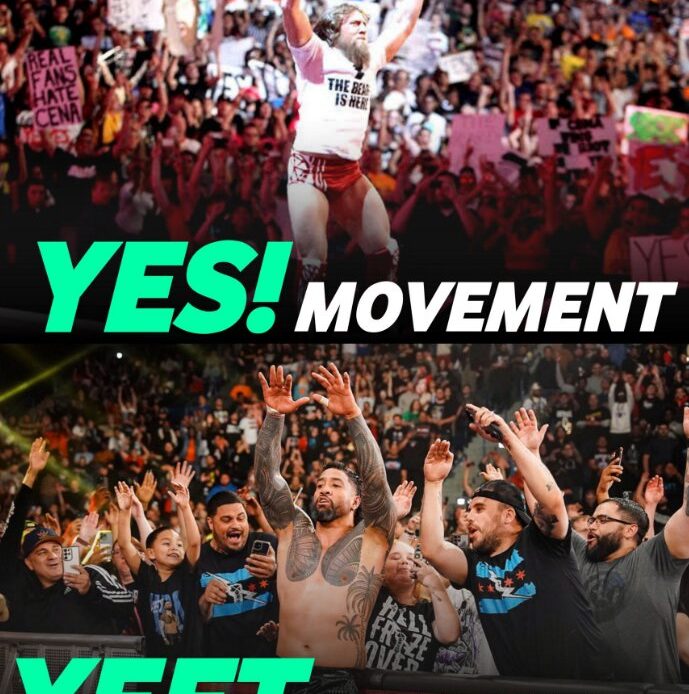WWE has always been a company that thrives on fan engagement, and over the years, several movements have defined the culture of professional wrestling. Two of the most iconic fan-driven movements in WWE history are the “YES Movement” led by Daniel Bryan and the “YEET Movement” popularized by Jey Uso. Both revolutions captured the hearts of fans, but which one had the biggest impact on WWE?
## The YES Movement – A Fan-Led Revolution

The “YES Movement” was more than just a chant; it was a statement. It was an uprising of fans who refused to be ignored, a collective voice that demanded change in WWE’s storytelling and booking. Daniel Bryan, the heart of the movement, was an unlikely underdog. Despite his immense in-ring skills and charisma, WWE management initially viewed him as a “B+ player”—good but not good enough to be the face of the company.
### The Build-Up to WrestleMania 30
The movement truly gained momentum leading into WrestleMania 30 in 2014. Bryan had been overlooked multiple times for the WWE Championship, with stars like John Cena, Randy Orton, and Batista being given the main event spotlight instead. However, fans refused to accept this reality. Week after week, arenas erupted in chants of “YES” demanding that Bryan be given the opportunity he had earned. The turning point came when fans hijacked segments, including a famous moment where Bryan led a ring full of fans in a sit-in protest, forcing WWE executives to listen.
### The WrestleMania Payoff
At WrestleMania 30, Bryan defeated Triple H in the opening match to earn his spot in the main event. Later that night, he overcame both Batista and Randy Orton in a thrilling triple-threat match to capture the WWE Championship. The image of Daniel Bryan, championship belts in hand, leading the crowd in deafening “YES” chants is one of the most emotional moments in WWE history.
### The Lasting Impact of the YES Movement
The YES Movement changed WWE in several ways:
– It proved that fan power could influence WWE’s decision-making.
– It helped redefine the idea of a WWE main-eventer, showing that size and corporate favoritism weren’t the only factors.
– It inspired future underdogs like Kofi Kingston, who would have his own “KofiMania” moment years later.
The movement demonstrated that wrestling was at its best when the fans were emotionally invested. Even after Bryan’s retirement and return, the YES chants remained a staple of WWE events, a testament to its enduring impact.
## The YEET Movement – A New Era of Connection

Fast forward to the modern WWE landscape, and a new movement has taken over— the “YEET Movement.” This phrase, associated with Jey Uso, has transcended wrestling to become a cultural phenomenon. Unlike the YES Movement, which was about fan rebellion, the YEET Movement is about energy, connection, and the evolution of WWE’s storytelling.
### The Rise of Main Event Jey Uso
Jey Uso had spent most of his career as a tag team competitor, achieving success alongside his twin brother Jimmy as The Usos. However, the Bloodline storyline catapulted him into singles stardom. His conflict with Roman Reigns, his struggles for independence, and his eventual turn against the Bloodline made Jey one of WWE’s most beloved stars.
### The Meaning Behind YEET
Unlike the YES Movement, which was based on defiance, YEET represents celebration, positivity, and inclusivity. The chant became synonymous with Jey’s rebellious spirit, his ability to energize a crowd, and his journey from the shadow of the Bloodline to his own path. It’s a simple but powerful phrase that WWE fans have embraced, turning it into a rallying cry.
### The YEET Movement’s Influence on WWE
– **Fan Engagement:** YEET has spread beyond wrestling, becoming a part of pop culture. WWE superstars, fans, and even mainstream media have adopted the phrase.
– **A Fresh Face in the Main Event Scene:** Jey Uso’s rise as a singles competitor is one of the best WWE storylines in years. His connection with fans is genuine, making him a top-tier babyface.
– **A Modern-Day Movement:** Unlike the YES Movement, which was about pushing against WWE’s decisions, the YEET Movement is about embracing what WWE has done right. It shows that when WWE builds a compelling character organically, the fans will respond positively.
## YES vs. YEET – Which One Was Bigger?

Both movements have had a significant impact on WWE, but comparing them isn’t easy. The YES Movement was about demanding change and breaking barriers, while the YEET Movement is about celebrating a beloved superstar and his personal journey.
### Factors in Their Impact
1. **Cultural Reach** – The YES Movement became a global phenomenon, influencing sports teams, mainstream media, and even political rallies. While the YEET Movement is growing, it hasn’t yet reached the same level of worldwide recognition.
2. **WWE Storyline Influence** – The YES Movement forced WWE to alter its WrestleMania plans in real time, while the YEET Movement is a result of WWE’s long-term storytelling.
3. **Longevity** – The YES Movement has lasted for over a decade, with fans still chanting “YES” at events. The YEET Movement is still fresh and growing, with the potential to establish a legacy of its own.
## Conclusion – The Evolution of WWE Fan Movements

WWE thrives on moments that create a deep emotional connection with its audience. The YES Movement was a revolutionary force that changed how WWE responded to its fanbase. The YEET Movement, on the other hand, represents a modern era where WWE builds a star the right way, and fans wholeheartedly embrace it.
Which movement was bigger? It depends on how you define “big.” If impact and influence on WWE’s creative direction are the criteria, the YES Movement takes the crown. However, if cultural relevance and fan interaction are considered, the YEET Movement has the potential to leave a lasting mark.
One thing is certain—both movements prove that WWE is at its best when the fans are truly invested. Whether it’s chanting “YES” or shouting “YEET”, these movements showcase the power of wrestling fandom and its ability to shape the WWE landscape for years to come.
